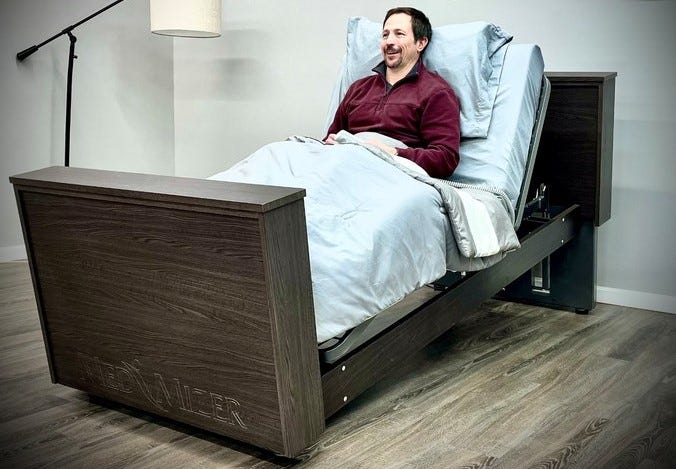
Struggling to get in and out of bed? Need relief from pressure sores or achey joints? Dealing with a chronic health condition? Home hospital beds can provide significant relief, improve health outcomes, and improve everyday life for a wide range of people.
Here are our top tips for choosing a home hospital bed to improve you or a loved one’s quality of life.
Manual, Semi-Electric, and Electric Hospital Beds


How much would you like to rely on manpower to change patient positioning in your home hospital bed?
Manual Hospital Beds: Rely on cranks to raise and lower the head and feet of the bed without motors
Semi-Electric Hospital Beds: Use a motorized system to raise and lower the head and knees of the bed, but often rely on a manual crank system for vertical adjustments.
Electric Hospital Beds: These beds are fully electric– users can change their position in bed, transition to a seated position, or raise and lower the platform of a bed with the push of a button.
If cost is an important consideration for you, manual and semi electric beds are the most affordable option.
Click here to learn more about the details between electric and manual beds.
Weight Capacity
First and foremost, you need to ensure that the bed can fully support your patient. The weight capacity of the bed can vary depending on type and model, but most standard hospital beds support a weight capacity of up to 500lbs.
Looking for a bed that can support larger patients? Look into bariatric beds, which can safely support patients of up to 1,000lbs.
Safety Features


When it comes to effective caregiving, nothing is more important than patient safety. Depending on your patient or loved one’s specific mobility and health concerns, certain hospital bed safety features can help support their day to day wellbeing.
Modern home hospital beds come with a wide range of safety features, including (but not limited to!):
- Bed Exit Alarms: Early warning systems can alert caregivers when a patient attempts to leave their bed or in the case of accidental falls.
- Bed Rails: Rails to help offer support to users when entering and exiting the bed, as well as preventing falls at night.
- Hi-Low Adjustability: Most fully electric hospital beds come with the ability to raise or lower the height of the bed platform. This allows for much safer transfers for patients who struggle with mobility.
Warranty
Each manufacturer provides their own warranty terms, which may protect against defects in materials and workmanship, mechanical failure, electrical components, and more.
Before you purchase a hospital bed, make sure to check the warranty terms to understand what’s covered (and what’s not).
Pro-Tip: When browsing the MedMart online catalog, we make it easy for you. Check out the “Warranty” tab on each product description page– we’ll tell you exactly what the warranty terms are for that hospital bed!
Mattress Options


If you’re looking to purchase a hospital bed package, they often come with the mattress included with the hospital bed frame. Be sure to look into the benefits of different mattress types to best suit your patient or facility.
Some common mattress types include:
- Foam: Single, dual, or tri-layered– foam mattresses are the most common mattress material.
- Pressure Redistribution: Mattresses designed to prevent bed sores and aches and pains.
- Air Alternation Mattress: Air mattresses that help relieve and redistribute pressure through inflated individual cells.
Bed Rail Options


Hospital bed rails, also known as bed guards or assist rails, attach to the side of a hospital bed to help improve safety, comfort, and independence for patients and seniors using home hospital beds.
They can come as part of a hospital bed package, or purchased separately. Some popular types of bed rails include:
- Quarter and Half-Length Bed Rails: These rails allow you to choose how far along the bedframe you’d like them to extend. Half-Length bed rails cover half the length of the bed, and help provide a barrier for patients to avoid falling out of bed while asleep.
- Assist Rails: Rails that are designed to provide support and a steady handhold for patients when entering and exiting the bed.
Cost
When searching for any at-home or facility medical equipment product, it’s important to stay in budget. Hospital beds can range in cost from as little as $600 to over $5,000 depending on the model and features included.
The good news? With hundreds of available hospital bed options, it’s guaranteed that you’ll be able to find a solution that fits your budget.
Additional Features


Don’t forget about additional features and add-ons! Differing home hospital bed models come with a wide range of features and bed accessories to make daily life and care easier. From built-in scales, to USB charging ports, under-bed lighting, and more– don’t forget to review the extra details that make each hospital bed unique.
The right home hospital bed can make all the difference in everyday life for both you and a loved one. We encourage you to browse our collection of industry-leading home hospital beds, or contact our team or product experts to find your perfect fit.